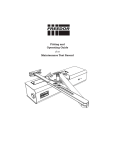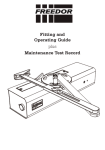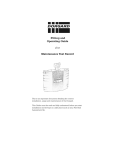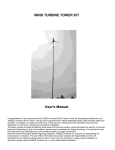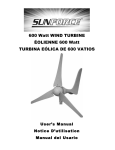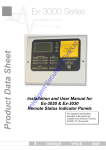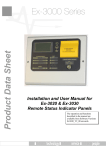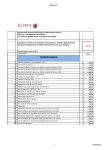Download Freedor User Guide - Discount Fire Supplies
Transcript
Freedor User Guide v1.8.1_Freedor User Guide 24/05/2013 10:05 Page 1 Fitting and Operating Guide plus Maintenance Test Record Freedor User Guide v1.8.1_Freedor User Guide 24/05/2013 10:05 Page 2 Keep this guide in a safe place. Contents Introduction and Glossary Contents of the Box Prior to Installation Page 2 3 4 Important Information 5 Door Type and Installation Position 6 Preparing Freedor 7 Installation - Radial Arm Set-up (Pull Side) 8 Installation - Closer Arm Installation (Pull Side) 9 Installation - Radial Arm Set-up (Push Side) 10 Installation - Closer Arm Installation (Push Side) 11 Installation - Mounting Freedor 12 Installation - Additional Functionality 13 Installation - Cover Assembly 14 Installation - Battery Installation and Start Sequence 15 Operation and Usage 16 Operation and Usage - Responding to a Fire Alarm 17 Sensitivity Adjustment 18 Battery Pack Replacement 19 Troubleshooting and FAQs 20 Beeps and Flashes 22 Maintenance Schedule 24 Maintenance Record 25 Commissioning Certificate 26 Manufacturer’s Warranty 27 Manufacturer’s Classification:As required By EN 1154:1997 and EN 1155:1997 ID of Certification Body: 1121 Registered Address:- Fireco Ltd., 30 New Road, BRIGHTON BN1 1BN, UK Power size: 3 Manufactured in the UK EN1154:1997 + A1:2002 Tested and found to comply with all the relevant clauses of those standards harmonised under the CPD EN1155:1997 + A1:2002 (EU Construction Products Directive) 1 1121 4 8 3 1 1 3 * 3 8 3 1* 1 0 Freedor User Guide v1.8.1_Freedor User Guide 24/05/2013 10:05 Page 3 Introduction and Glossary Freedor is a battery operated electrically powered free-swing door closer for fire doors with Category B signal activation to BS7273-4. It is designed to allow users to hold open a fire door safely and legally, and it will automatically release upon detecting the fire alarm. Glossary of Terms used in this guide. Latching Angle - The position of the radial arm bolt on the radial arm will determine the angle at which Freedor will enter free-swing mode. There is a minimum and maximum latching angle depending on the installation: between 65 & 105 degrees when installed on the pullside and between 85 & 95 degrees when installed on the pushside. Maximum Opening Angle - Depending on the installation, Freedor will limit the maximum opening angle of the door: 105 degrees when installed on the pull side and 135 degrees when installed on the push side. Door closer mode - The default mode for Freedor. No matter what angle Freedor is opened to, it will close the door. Free-swing mode - If Freedor is in the free-swing mode, it will act as if there is no door closer fitted, after it is opened to the latching angle. Fire Alarm mode - Upon detecting the noise of a fire alarm, Freedor will sound ten “HiLo” tones whilst flashing the LED red. Freedor will cause the door to close if it is being held open. Fail-to-Safe mode - If Freedor fails a self-test, it will fail-to-safe and close the door. The unit will then start to beep and flash its LED in a sequence dependant on the error. During this mode, the reset button will not be useable and Freedor will not hold the door open until the error has been cleared. Reset Button - Depressing the reset button for 1 to 2 seconds will change the mode that Freedor is currently in. Holding the reset button for 10 seconds will cause Freedor to perform a soft-reset. Refer to the Operation and Usage section for more information on how to operate the Freedor. Battery tamper microswitch - Connecting the battery pack and securing the two battery lift screws will depress a tamper switch. If the battery lift is removed during operation, the tamper switch will change state and Freedor will enter a fail-to-safe mode and close the door. PCB (Printed Circuit Board) - The PCB houses all the electronics used to make Freedor function. It sits above the magnet assembly and has the DIP switches and variable resistor which sets the unit’s functionality and audio sensitivity respectively. 2 Freedor User Guide v1.8.1_Freedor User Guide 24/05/2013 10:05 Page 4 Contents of the Box Please check that you have all the contents listed below. Tools and Equipment Required: The Freedor box contains: 1 x Freedor unit • Pozidriv No. 2 screwdriver 1 x User Guide • Flat-blade screwdriver (no wider than 6mm) 1 x Fitting Template • Electric drill 1 x Closer Arm Pack • Drill bits: 3mm diameter 1 x Parallel Arm Bracket • 7 & 11mm socket and ratchet 1 x Battery Pack • 13mm spanner 1 x Freedor Adhesive Logo • Stud and cable detector 1 x Radial Arm 1 x Closer Bolt & Radial Arm Bolt Bag contains: 1 x Closer Bolt Assembly, 1 x Radial Arm Bolt Assembly 3 x Freedor Body & Arm Fixtures contains: 8 x No. 10 PH Screw, 4 x No. 10 CSK Screw, 2 x M5 Short PH Screw, 1 x Black Plastic Screwdriver Wall Mount Claw Blanking Closer Arm Plate • Marker pen • Safety goggles • Allen key (included if required) Radial Arm Radial Arm Bolt Cover Sensitivity Adjustment Hole Microphone Hole Closer Arm Closer Arm Screws Reset Button LED Backplate 3 Freedor User Guide v1.8.1_Freedor User Guide 24/05/2013 10:05 Page 5 Prior to Installation Please ensure the following: 1. That a suitable Automatic Fire Detection and Alarm system is installed; 2. The Fire Alarm system is working correctly, i.e. the sounders work when activated; 3. That the door swings freely and closes in a controlled manner into its rebate. This is particularly important for fire/smoke doors which should be hung on hinges complying with BS EN 1935 and that latches and smoke seals be of a type that offer minimum resistance to closing. Failure to address these requirements may result in an ineffective fire/smoke door installation; 4. Freedor is of a suitable power size for the fire door. Freedor is suitable for fire doors up to 950mm wide and 60kg; 5. The door, the door frame and surrounding fixing points are checked for potential interferences or danger, such as electrical wiring; 6. An internal stop should be installed to prevent Freedor being opened past its maximum opening angle; i.e. 105 degrees when installed on the pull side and 135 degrees when installed on the push side. The stop must be of a standard design and correctly fixed; 7. Freedor should be included in the Fire Risk Assessment (as required by UK Legislation); 8. No other door holding or closing devices are used in conjunction with Freedor. The use of these devices can hinder the operation of Freedor and cause faults to develop. The Freedor unit will only work once installed and commissioned. It must therefore be installed by a Fireco Approved Freedor Installer. No responsibility can be accepted by the manufacturer if these installation instructions are disregarded. 4 Freedor User Guide v1.8.1_Freedor User Guide 24/05/2013 10:05 Page 6 Important Information Freedor must only be used for the purpose for which it is designed. It is not suitable for external use. Read this guide and follow the instructions carefully. Keep this guide in a safe place e.g. in the Fire Risk Assessment file for future reference. The standard EN 1155 requires that a fire door is not held open at an angle of less than 65 degrees. Freedor, when installed correctly also complies with BS 7273-4 Category B. Supplementary information about the sound generated by a fire alarm: The British Standard for fire alarm installations, BS 5839-1: 2013, (Clause 16.2.1), states: The sound pressure level of alarm signals should be: generally, throughout all accessible areas of the building not less than 65dB(A). Where the sound pressure level of background noise is greater than 60dB(A), the sound pressure level of the fire alarm signal should be 5dB above the sound pressure level of the background noise. Power Supply Rated Voltage: 9.82V Power Consumption (at rated voltage): 0.05W Protection: Resettable solid state fuse Freedor constantly checks the voltage of the connected battery pack and will fail-to-safe on detecting the voltage reaching a low level. Freedor will not start-up if a low voltage condition is detected. Only connect new battery packs supplied by Fireco Ltd. or by approved suppliers of Freedor. Failure to do so and the use of unauthorised battery packs could result in damage to the product and cause it to become unsafe. 5 Freedor User Guide v1.8.1_Freedor User Guide 24/05/2013 10:05 Page 7 Door Type and Installation Position Freedor can be installed in one of four positions; clockwise or anti-clockwise opening doors, and on the pull side or push side of the door. Using the diagram below, determine where you wish Freedor to be installed. Clockwise Opening Door Pull Side Push Side Anti-clockwise Opening Door Pull Side Push Side During the installation process, the method for installing Freedor will differ depending on which side of the door it is to be installed. If the title of the installation section of this guide mentions a specific side, make sure it is the correct side for the installation. This rule also applies to various steps which will present a “pull” and “push” side option. If the installation section does not mention a specific side, it is correct to follow for either installation type. Alarm Bell/Sounder Consideration When choosing the side of the fire door on which the Freedor is mounted, consider the relationship between the microphone and the alarm bell/sounder when the door is in the open position. Ideally, there should be a clear “line of sight” between the microphone and the alarm/bell sounder. 6 Freedor User Guide v1.8.1_Freedor User Guide 24/05/2013 10:05 Page 8 Preparing Freedor Freedor requires minor dis-assembly to prepare it for installation upon the door. Follow the instructions detailed below to prepare Freedor for installation. 1. Remove the Freedor body from under the top tier of packaging. 2. Unscrew the 2 screws holding down the blanking plate and lift it away. 3. Unscrew the 2 screws holding the battery lift and slide it gently away from the cover. 4. Gently push the battery lift legs toward each other so that they can clear the cover and remove the battery lift. 5. Once the 4 holding screws are removed from the cover (2 from the blanking plate, 2 from the battery lift), the cover can be removed. Pull Side instructions are found on pages 8 & 9, continuing on page 12. Push Side instructions are found on pages 10 onward. 7 Freedor User Guide v1.8.1_Freedor User Guide 24/05/2013 10:06 Page 9 Installation - Radial Arm Set-up (Pull Side) Pull side installation only - for push side instructions, see page 10-11. 1. Remove the radial arm and the radial arm bolt assembly from the packaging. The radial arm bolt assembly contains: 1 x M8 Bolt, 1 x Metal Sleeve and 1 x M8 Nyloc Nut. 2. Using the diagrams below, select the angle at which the door will enter free-swing mode and insert the bolt through the slot in the radial arm at the correct position. The diagrams show the minimum, maximum and right-angle installation points for the radial arm bolt; the bolt can be installed at any position between the minimum and maximum points. Clockwise Opening 3. Assemble the radial arm bolt by sliding the sleeve and the nyloc nut onto the bolt. Tighten down the nut to fasten the bolt to the radial arm. 65 degree latching angle (min.) 90 degree latching angle 105 degree latching angle (max.) 90 degree latching angle 105 degree latching angle (max.) Anti-clockwise Opening 65 degree latching angle (min.) 8 Freedor User Guide v1.8.1_Freedor User Guide 24/05/2013 10:06 Page 10 Installation - Closer Arm Installation (Pull Side) Pull side installation only - for push side instructions, see page 10-11. 1. Place the radial arm and radial arm bolt assembly on the square pinion of the closer so that the radial arm nib sits at right angles to the backplate. 2. Take the largest metal washer from the door closer arm pivot pack and place it on the central recess of the radial arm. 3. Push the nylon shoulder washer into the door closer arm from the flat bottom side. Place the door closer arm on top of the radial arm, ensuring the door closer arm sits between the Freedor PCB and the radial arm bolt. 4. Place the nylon washer and metal washer into the door closer arm (in that order). Tighten the door closer arm to the closer body using the door closer bolt. Tighten the bolt until the arm is secure ensuring it is not over tightened (5Nm torque max.). Check that the arm can move with little resistance, loosen the bolt if necessary. Installation instructions continue on page 12. Note. The two diagrams below are examples of how the backplate assembly should look at this stage. Clockwise Opening Anti-clockwise Opening 9 Freedor User Guide v1.8.1_Freedor User Guide 24/05/2013 10:06 Page 11 Installation - Radial Arm Set-up (Push Side) Push side installation only - for pull side instructions, see page 8-9. 1. Remove the radial arm and the radial arm bolt assembly from the packaging. The radial arm bolt assembly contains: 1 x M8 Bolt, 1 x Metal Sleeve and 1 x M8 Nyloc Nut. 2. Using the diagrams below, select the angle at which the door will enter free-swing mode and insert the bolt through the slot in the radial arm at the correct position. The diagrams show the minimum, maximum and right-angle installation points for the radial arm bolt; the bolt can be installed at any position between the minimum and maximum points. Clockwise Opening 3. Assemble the radial arm bolt by sliding the sleeve and the nyloc nut onto the bolt. Tighten down the nut to fasten the bolt to the radial arm. 85 degree latching angle (min.) 90 degree latching angle 95 degree latching angle (max.) 90 degree latching angle 95 degree latching angle (max.) Anti-clockwise Opening 85 degree latching angle (min.) 10 Freedor User Guide v1.8.1_Freedor User Guide 24/05/2013 10:06 Page 12 Installation - Closer Arm Installation (Push Side) Push side installation only - for pull side instructions, see pages 8-9. 1. Place the radial arm with the newly fitted radial arm bolt on the square pinion of the closer so that the radial arm nib sits at a 45 degree angle to the backplate, facing toward the push button. 2. Take the largest metal washer from the door closer arm pivot pack and place it on the central recess of the radial arm. 3. Push the nylon shoulder washer into the door closer arm from the flat bottom side. Place the door closer arm atop the radial arm, ensuring the door closer arm sits between the backplate and the radial arm bolt. 4. Place the nylon washer and metal washer into the door closer arm (in that order). Tighten the door closer arm to the closer body using the door closer bolt. Tighten the bolt until the arm is secure ensuring it is not over tightened (5Nm torque max.). Check that the arm can move with little resistance, loosen the bolt if necessary. Installation instructions continue on page 12. Note. The two diagrams below are examples of how the backplate assembly should look at this stage. Clockwise Opening Anti-clockwise Opening 11 Freedor User Guide v1.8.1_Freedor User Guide 24/05/2013 10:06 Page 13 Installation - Mounting Freedor Pull Side 1. Place the fitting template against the door with the required orientation facing you (template A for pull side installation and template B for push side installation). 2. Fold the template along the upper fold line and hold it on the door, following the instructions for correct placement. Push Side 3. Mark through the template in the desired locations for the Freedor body and wall mount closer arm fixtures. Drill pilot holes using a 3mm drill bit fitted in an electric drill. 4. Secure the Freedor to the door using the 6 x PH screws. Match the orientation of the unit to the template used when make the pilot holes. Ensure the unit is level before tightening the screws fully. 5.A. Pull Side Installation. Using the two closer arm fitting screws, affix the wall mount closer arm to the door frame following the template for correct orientation. Continue to step 7. OR 5.B. Push Side Installation. Take the wall mount closer arm and affix this to the parallel arm bracket using the short screws included in the same pack as the bracket fitting screws. Using the four parallel arm bracket screws, affix the parallel arm bracket to the underside of the door frame. 6. Locate the claw spring connected between the claw and the backplate. Connect the claw spring to the upper spring retainer on the backplate. The claw should be protuding from the top of the unit. 7. Loop the battery input wiring over the closer so it is accessible from beneath the closer. 12 Freedor User Guide v1.8.1_Freedor User Guide 24/05/2013 10:06 Page 14 Installation - Additional Functionality (inc. Automatic Free-swing) The factory default setting for DIP switches 1, 2 & 4 is OFF, DIP switch 3 is set to ON and should only be turned OFF if Automatic Free-swing is to be disabled, see below for details. Freedor will only change modes if prompted to do so by the user or a fire alarm or fault is detected. Freedor can perform night-time releases, automatically enter free-swing mode or perform a weekly self-test by setting the appropriate DIP switch. When adjusting the DIP switches, ensure the supplied black screwdriver is used to avoid damage due to static discharge. DIP Release Reset Night-time Release - DIP switches 1 & 2 Switch Time Time 1 20:00 8:00 2 21:00 7:00 1 and 2 22:00 6:00 This function will place Freedor into door closer mode and it will not enter free-swing mode until the reset time is reached. Whenever Freedor starts-up or performs a soft-reset, it will assume the time is 12:00 noon. The times stated in the table to the left are correct if Freedor starts-up at 12:00 noon. Using the night-time release table on the left, choose the time span for Freedor to enter night-time release. With the black plastic screwdriver supplied, push the DIP switches toward the PCB for the time range selected. Automatic Free-swing - DIP switch 3 DIP Switch 3 ON 4 ON Self-Test Tones Automatic Free-swing ON Weekly Self-test ON If Freedor closes the door due to either the detection of a fire alarm, pressing of the push button, a night time release or a self test, then by default Freedor will revert to Free-swing mode 30 seconds after the door closes. For night time release this will be when the reset time is reached. The door then only has to be re-opened beyond the set angle to hold it open. Turning DIP switch 3 to OFF disables Automatic Free swing mode and Freedor operates in door closer mode, requiring the reset button to be pressed after the door closes. Weekly Self-Test - DIP switch 4 If Freedor is to perform a weekly self-test, set DIP switch 4 to ON. 6½ days after start-up, Freedor will perform a self-test; it will then perform a self-test every 7 days at the same time. If the door is being held open during a self-test, it will be released and require resetting by either the reset button, or will automatically reset if DIP switch 3 is ON. 13 Freedor User Guide v1.8.1_Freedor User Guide 24/05/2013 10:06 Page 15 Installation - Closer Speed Adjustment and Cover Assembly Pull Side 1.A. Pull Side Installation. Slide the door closer arm around the wall mount closer arm and pull the door closer arm so that the wall mount closer arm is at a right angle to the door. Secure the arm in this position using the two closer screws. Continue to step 2. OR Push Side 1.B. Push Side Installation. Slide the door closer arm around the wall mount closer arm and pull the door closer arm so that the wall mount closer arm is parallel to the door. Secure the arm in this position using the two closer screws. 2. Freedor will now act as a door closer, allowing the adjustment of the closing and latching speeds of the closer. To increase the closing rate of either the closing or latching speed, loosen the appropriate regulator bolt; to slow the rate, tighten the regulator bolt. The regulator bolts are located on the closer. The closing speed is governed by the bolt labelled 1 and the latching speed is governed by the bolt labelled 2. 3. Slide the cover over the Freedor body ensuring that the cover is orientated such that the microphone and the sensitivity adjustment holes are over the PCB. 4. Place the Freedor logo sticker on the cover indent and place the plastic pinion cover over the closer pinion. 5. Place the blanking plate on top of the cover and secure it with the fixtures removed during the installation preparation. 6. Similar to the removal of the battery lift during the Freedor installation preparation, gently push the battery lift legs towards each other so the battery lift is able to be slid into its original position. Do not secure the battery lift. 14 Freedor User Guide v1.8.1_Freedor User Guide 24/05/2013 10:06 Page 16 Installation - Battery Installation and Start Sequence 1. With the Freedor fully assembled and closing the door correctly, take the battery pack from the Freedor packaging and record the installation date on the label fitted on the battery pack. 2. Connect the battery pack to the Freedor’s battery pack connector that should be protruding from the bottom of the cover. 3. With the battery pack connected, place it on the battery lift. Push the battery lift up into the Freedor unit. Secure the battery lift with the screws removed during the installation preparation. 4. Once the battery lift is secured and the battery pack is connected, hold the reset button on the side of Freedor down until a continuous tone is heard. At this point release the button and the Freedor start sequence will commence. 5. The first 4 tones of the Freedor start sequence relate to the state of the 4 DIP switches. A “Hi” tone indicates the DIP switch is OFF and a “Lo” tone indicates the DIP switch is ON. The factory default settings, only DIP switch 3 ON, will result in a “Hi - Hi - Lo - Hi” sequence of tones. 6. After the Freedor start sequence has finished, Freedor will assume the time is 12:00 noon. 15 Freedor User Guide v1.8.1_Freedor User Guide 24/05/2013 10:06 Page 17 Operation and Usage Operation of Freedor differs, dependent on whether automatic free-swing is on (DIP switch 3 ON) or off (DIP switch 3 OFF). Automatic Free-swing ON - DIP switch 3 ON Normal Usage A few seconds after Freedor is powered up, Freedor will enter free-swing mode. Open the door past the latching angle and Freedor will hold the door open. Pressing the Reset Button When the reset button is pressed, Freedor will enter door closer mode, closing the door. Freedor will remain in door closer mode for 30 seconds before automatically entering free-swing mode. When the door is opened past the latching angle, Freedor will hold the door open again. Night-time Release If night-time release is set via the DIP switches (OFF by default), Freedor will enter door closer mode and close the door at the allotted release time. Until the reset time is reached, Freedor will not enter free-swing mode. At the reset time, Freedor will automatically enter free-swing mode, holding the door open when it is opened past the latching angle. Automatic Free-swing OFF - DIP switch 3 OFF Normal Usage Freedor will enter door closer mode when powered up. Pressing the Reset Button When the reset button is pressed, Freedor will switch between door closer and free-swing mode, or vice versa. Night-time Release If night-time release is set via the DIP switches (OFF by default), Freedor will enter door closer mode and close the door at the allotted release time. Until the reset time is reached, Freedor will not enter free-swing mode. After the reset time is reached, Freedor is able to be switched into free-swing mode using the reset button. 16 Freedor User Guide v1.8.1_Freedor User Guide 24/05/2013 10:06 Page 18 Operation and Usage - Responding to a Fire Alarm While in free-swing mode, Freedor will periodically sample surrounding sound levels to detect if a fire alarm is operating. If a potential fire alarm is detected, sound levels are sampled more frequently for 15 seconds. Upon verification of a fire alarm, Freedor will close the door. Testing Freedor to a Fire Alarm 1. Set Freedor to free-swing mode, open the door past the latching angle and allow Freedor to engage. 2. Sound the fire alarm until Freedor causes the door to close. 3. The LED on the side of Freedor should flash every 2 seconds to indicate it is detecting the sound of the fire alarm. 4. Freedor should release the fire door in under 20 seconds. 5. When Freedor is ready to release the door, it will sound a “Hi - Lo” warning tone, repeated a total of 10 times before releasing the door. 6.A. Automatic Free-swing ON - DIP switch 3 ON 30 seconds after Freedor has closed the door, Freedor will automatically reset to free-swing mode. Once the door has been opened past the set angle, Freedor will hold the door open again. OR 6.B. Automatic Free-swing OFF - DIP switch 3 OFF 10 seconds after Freedor has closed the door, the reset button will reactivate. Pressing the reset button will switch Freedor from door closer to free-swing mode. Note. If Freedor fails to react to the sound of the fire alarm, the sensitivity of the unit will need to be adjusted (see Sensitivity Adjustment). Alterations to the premises i.e. new furniture, new carpets etc., might alter the audibility of the fire alarm. Following alterations, a fire alarm test must be carried out to ensure that Freedor responds. 17 Freedor User Guide v1.8.1_Freedor User Guide 24/05/2013 10:06 Page 19 Sensitivity Adjustment Each environment will vary and Freedor may need adjusting to suit individual conditions. When making a necessary adjustment use the black plastic screwdriver supplied. Take care not to over adjust as this will render the unit inoperative. Adjusting sensitivity if Freedor is not sensitive enough, i.e. does not respond to the fire alarm: Acoustic Sensitivity Minimum Release Level 1. Carefully insert the black plastic screwdriver into the aperture on the front of the unit, next to the 7 holes for the microphone. 2. Turn clockwise through no more than 5 degrees (a small angular adjustment corresponds to a large alteration in sensitivity). 3. Test Freedor’s response to the fire alarm. 60dB(A) 4. If problems persist repeat steps 1-3. 80dB(A) Note. The adjustment screw is limited in both directions, once there is a resistance against turning stop to avoid damaging the unit. If Freedor is too sensitive (responds to no apparent sound) follow steps 1-4, but turn anti-clockwise in Step 2. Note. When turned completely clockwise, Freedor needs to detect sound pressure levels of around 60dB(A) to register a fire alarm. When turned completely anti-clockwise,Freedor needs to detect sound pressure levels of around 80dB(A) to register a fire alarm. 18 Freedor User Guide v1.8.1_Freedor User Guide 24/05/2013 10:06 Page 20 Battery Pack Replacement When the product determines that a battery low level has been reached (approximately 24 months), Freedor will fail-tosafe and will not allow the door to enter free-swing mode. If Freedor is sounding a “Hi-Lo Hi-Lo” tone once every 32 seconds, the battery pack will need replacing. 1. Unscrew the 2 screws securing the battery lift and let it gently drop down to expose the battery pack. 2. Remove the battery pack from the unit and disconnect the battery pack connector. 3. Record the installation date on the label fitted to the battery pack. 4. Connect the new battery pack and place it on the battery lift. Push the battery lift up into the Freedor unit. Re-secure the battery lift with the 2 screws. 5. Press the reset button on the side of Freedor until a continuous tone is heard. At this point release the button and the Freedor start sequence will commence. Note. Battery levels are checked once every 30 seconds in all modes. 19 Freedor User Guide v1.8.1_Freedor User Guide 24/05/2013 10:06 Page 21 Troubleshooting and FAQs 1. Why is Freedor not releasing when the Fire Alarm sounds? • Check fire alarm sounds for at least 30 seconds. • Check fire door is free to close unhindered. • Check the sound pressure level from the fire alarm is equal to or exceeds 65dB(A) at the place where the Freedor is fitted. • Adjust the sensitivity of the Freedor unit (see Sensitivity Adjustment). 2. Why does Freedor release if the fire alarm is not sounding? • As a safety feature, Freedor has to release to any continuous sound that it detects equal to or above 65dB(A) as this sound could potentially mask the sound of a fire alarm. • Check night-time release settings. • Adjust the sensitivity of the Freedor unit (see Sensitivity Adjustment). • Check battery pack, is the unit beeping? 3. Why does Freedor not retain the door in an open position after the door has been opened past the latching angle? • Ensure Freedor is in free-swing mode. Press the reset button and a tone (HiLo) should sound. • If a tone (LoLoHiHi) produced every time the reset button is pressed? If so, Freedor is currently in night-time release mode and will not become active again until the reset time is reached. • Try performing a soft-reset. Press and hold the reset button until a long “Lo” tone is heard. Freedor will reset and carry out the start sequence again. • Check that the battery lift is closed (secured up to the cover) and the battery pack is correctly installed. 20 Freedor User Guide v1.8.1_Freedor User Guide 24/05/2013 10:06 Page 22 Troubleshooting and FAQs continued 4. How can I reset the Freedor without re-installing the battery pack? • Press and hold the reset button until a long “Lo” tone is heard. Freedor will reset, performing the start sequence again.. A soft-reset will have the same effect as re-installing the battery pack, unless Freedor has failed-to-safe. In the event of a failure or tones are heard from Freedor, refer to the Beeps and Flashes section for more information. 5. How do I check/change the DIP switch settings or change the closing/latching speed once Freedor has been installed? • Performing a soft-reset (pressing and holding the reset button for 10 seconds) will cause Freedor to reset, going through its start sequence. During the start sequence, Freedor will sound 4 sequential tones after the initial long lo tone. These tones relate to the state of the 4 DIP switches. See the Beeps and Flashes section for more information on these tones. • The cover needs to be removed to access the closer and DIP switches. To remove the cover, follow the instructions found in the Preparing Freedor section. Freedor does not need to be removed from the door to change the closer speed or DIP switch settings. 6. Why is Freedor producing tones and flashing its LED? • See Beeps and Flashes section for information relating to each sequence. 21 Freedor User Guide v1.8.1_Freedor User Guide 24/05/2013 10:06 Page 23 Beeps and Flashes Beep/Flash Sequence What it means? Remedy Long Lo Tone Indicates start of power up test. No action required. Lo Tone - DIP switch ON Hi Tone - DIP switch OFF Example. By default, Freedor will sound “Hi - Hi - Lo - Hi” after the initial long lo tone to indicate that DIP switches 1, 2 & 4 are OFF and DIP switch 3 is ON. 4 sequential tones sounded after the initial long lo tone, indicating the states of the 4 DIP switches in order. No action required. Lo - Mid - Hi Successful self-test. No action required. During Start Sequence During standard operation Key: O* LED flash GREEN LED flash RED *---(32secs)---*---(32secs)---*---(32secs)---*---etc. LED indicates that Freedor is working properly. No action required. Hi Lo * Freedor is preparing to change modes. No action required. HiLo – HiLo – HiLo – HiLo – HiLo – HiLo – HiLo – HiLo O-------O-------O-------O-------O-------O-------O-------O HiLo – HiLo O-------O Freedor is preparing to release the door due to a fire alarm. No action required. LoHi – LoHi – LoHi – LoHi – LoHi – LoHi – LoHi – LoHi O-------O-------O-------O-------O-------O-------O-------O – LoHi – LoHi O-------O Freedor is resetting after releasing the door due to a fire alarm. No action required. and HiLo – HiLo – HiLo – HiLo *--------*--------*--------* 22 Freedor User Guide v1.8.1_Freedor User Guide 24/05/2013 10:06 Page 24 Beeps and Flashes continued Beep/Flash Sequence Error Modes What it means? Remedy Battery tamper switch not depressed. This will occur during power up but will stop when the battery lift is secured. 1. Unfasten the battery lift. 2. Disconnect the battery pack 3. Wait 10 seconds. 4. Connect the battery pack. and secure the battery lift. 5. Hold down the reset button to power up Freedor. Key: * LED flash GREEN O LED flash RED Lo – (2secs) – Lo – (2secs) – Lo – (2secs) – etc. O----------------O----------------O----------------etc. After each mode change there is a 10 second period where the reset button is unusable. Wait 10 seconds and try again. LoLoHiHi HiHiHiHiLoLoLoLo---(4secs)--HiHiHiHiLoLoLoLo---(4secs)--- etc. HiLo-------(17 minutes)-- etc. HiLoHiLo------(32 secs)--etc. Reset Button is currently unusable. If Freedor has entered fail-safe mode due to night-time release, Freedor will be unusable until the night-time reset time is reached. Indicates possible latching fault. 1. Open the door past the latching angle and check if the door is being held open. 2. Press and hold the reset button until a soft-reset occurs (10 seconds). 3. Ensure no foreign bodies, such as wires, debris, etc. are interfering with the device. 4. Replace the battery pack and repeat steps 1-3. 5. Contact Freedor Technical advice line if Freedor holds open the door. Low battery mode. Battery levels are getting close to critical levels. Freedor will function normally until critical battery levels are reached. Critical battery mode. Battery levels have reached a critical level and Freedor has failed-to-safe. Replace battery pack. 23 Freedor User Guide v1.8.1_Freedor User Guide 24/05/2013 10:06 Page 25 Maintenance Schedule Preventative maintenance and regular testing will ensure that Freedor functions correctly at all times. Keep the Maintenance Record up to date. Weekly Check Freedor is in the free-swing mode, open the door beyond the latching angle and allow it to settle back. Sound the fire alarm, before the alarm has sounded for 30 seconds the door should be released and close. If the door is not released, refer to the troubleshooting section. Monthly Carry out the weekly test and in addition clean the unit checking that the 7 holes for the microphone aperture are open and clear of any dust, dirt etc. Freedor can be cleaned with a slightly damp cloth. 6 Monthly Carry out the weekly and monthly schedule and in addition, check: 1. The Freedor unit for signs of wear; 2. The Freedor unit is firmly attached to the door, along with any arm attachments. Yearly Carry out the 6 monthly schedule and if possible. Bi-Yearly Replace battery pack. Note and Warning • The unit is designed to detect low battery power or possible faults, it will give a continual warning (sound a series of beeps) and will fail to safe (no longer operate as a hold open device). 24 Freedor User Guide v1.8.1_Freedor User Guide 24/05/2013 10:06 Page 26 Maintenance Record The log sheet below is designed to cover a 12 month period and should be filled out after each alarm test. This log is a formal record of the test and maintenance schedule carried out by a competent (responsible) person(s) throughout the history of the installation of the Freedor unit. Freedor Information Serial Number FD Date DIP switches ON Installer Notes Location Week Result Date Installation Information Sign Week Result 1 2 3 4 5 6 7 8 9 10 11 12 13 14 15 16 17 18 19 20 21 22 23 24 25 26 27 28 29 30 31 32 33 34 35 36 37 38 39 40 41 42 43 44 45 46 47 48 49 50 51 52 25 Date Sign Freedor User Guide v1.8.1_Freedor User Guide 24/05/2013 10:06 Page 27 Commissioning Certificate Certificate of commissioning for the electrically powered hold-open device(s) (please delete as appropriate) at: Address:........................................................................................................................ .................................................................................................................................................................. .................................................................................................................................................................. I/we being person(s) responsible (as indicated by my/our signatures below) for the commissioning of the above, particulars of which are set out below, CERTIFY that the equipment and release arrangements I/we have commissioned complies to the best of my/our knowledge and belief with the recommendations of BS 7273-4:2007 for the category of actuation described below, except for the variations, if any, stated in this certificate. Name (in block letters):.............................................................Position:............................................... Signature:...................................................................................Date:..................................................... For and on behalf of:................................................................................................................................ Address:................................................................................................................................................... .................................................................................................................................................................. ............................................................................................Postcode:...................................................... The extent of liability of the signatory is limited to the equipment and arrangements described below. O Category B (acoustically activated Freedor) Variations for the recommendations of BS 7273-4 (Clause 7)............................................................. .................................................................................................................................................................. .................................................................................................................................................................. Brief description of release mechanisms, method(s) of actuation (see 7273-4:2007, Clause 8) and system design (see BS 7273-4:2007, Clause 10)............................................................................ .................................................................................................................................................................. .................................................................................................................................................................. O All equipment operates correctly. O Installation work is, as far as can reasonably be ascertained, of acceptable standard. O I/we have carried out commissioning in accordance with recommendations of BS 7273-4:2007, 21.5 O Suitability documentation has been completed before/after (delete as applicable) release mechanisms become operational...................................................................................................... .................................................................................................................................................................. .................................................................................................................................................................. .................................................................................................................................................................. Maintenance: it is strongly recommended that, after completion, Freedor is maintained in accordance with BS 7273-4:2007, Clause 22. User Responsibilities: the user should appoint a responsible person to supervise routine testing of release mechanisms in accordance with BS 7273-4:2007, 22.1 and to supervise all matters pertaining to the associated fire detection and fire alarm system in accordance with BS 5839-1:2013, section 7. 26 Freedor User Guide v1.8.1_Freedor User Guide 24/05/2013 10:06 Page 28 Manufacturer’s Warranty Fireco Limited (“we” and “us”) warrants to the customer (“you” and “your”) that the product will be free from defects in material and workmanship for a period of 24 months from the date of purchase. If the product is defective whilst under warranty we will, at our option, repair the product or replace it free of charge. If the product appears to develop a defect while under warranty please first check that the product is being correctly used in accordance with this Fitting and Operating Guide and that the battery packs are functioning. If this does not resolve the problem, please contact us via e-mail or telephone the Freedor Technical Advice line below. The warranty does not apply to any defect in the product arising from fair wear and tear, wilful damage, accident, negligence by you or any third party, abnormal working conditions, failure to follow the instructions in this guide, misuse or alteration or repair of the product without our prior approval. The warranty does not cover the battery pack which might need to be replaced within the period of the warranty. We will not be liable to you for any loss of profits, administrative inconvenience or indirect or consequential loss or damage arising out of any defect in the product. Where the products are sold under a consumer transaction (as defined by the UK Consumer Transactions (Restrictions on Statements) Order 1976) your statutory rights are not affected by the terms of this warranty. Version 1.8.1 For Technical Assistance contact the UK Technical Advice line on: 0845 241 7575 (Local Rate) or +44 (0) 1273 320 688 e-mail us at help@firecoltd.com www.firecoltd.com For all other queries please contact your supplier.




























